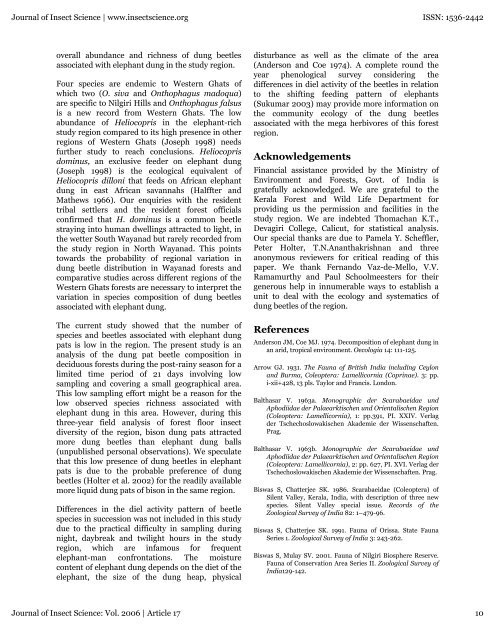Guild structure, diversity and succession of dung beetles associated ...
Guild structure, diversity and succession of dung beetles associated ...
Guild structure, diversity and succession of dung beetles associated ...
Create successful ePaper yourself
Turn your PDF publications into a flip-book with our unique Google optimized e-Paper software.
Journal <strong>of</strong> Insect Science | www.insectscience.org ISSN: 1536-2442<br />
overall abundance <strong>and</strong> richness <strong>of</strong> <strong>dung</strong> <strong>beetles</strong><br />
<strong>associated</strong> with elephant <strong>dung</strong> in the study region.<br />
Four species are endemic to Western Ghats <strong>of</strong><br />
which two (O. siva <strong>and</strong> Onthophagus madoqua)<br />
are specific to Nilgiri Hills <strong>and</strong> Onthophagus falsus<br />
is a new record from Western Ghats. The low<br />
abundance <strong>of</strong> Heliocopris in the elephant-rich<br />
study region compared to its high presence in other<br />
regions <strong>of</strong> Western Ghats (Joseph 1998) needs<br />
further study to reach conclusions. Heliocopris<br />
dominus, an exclusive feeder on elephant <strong>dung</strong><br />
(Joseph 1998) is the ecological equivalent <strong>of</strong><br />
Heliocopris dilloni that feeds on African elephant<br />
<strong>dung</strong> in east African savannahs (Halffter <strong>and</strong><br />
Mathews 1966). Our enquiries with the resident<br />
tribal settlers <strong>and</strong> the resident forest <strong>of</strong>ficials<br />
confirmed that H. dominus is a common beetle<br />
straying into human dwellings attracted to light, in<br />
the wetter South Wayanad but rarely recorded from<br />
the study region in North Wayanad. This points<br />
towards the probability <strong>of</strong> regional variation in<br />
<strong>dung</strong> beetle distribution in Wayanad forests <strong>and</strong><br />
comparative studies across different regions <strong>of</strong> the<br />
Western Ghats forests are necessary to interpret the<br />
variation in species composition <strong>of</strong> <strong>dung</strong> <strong>beetles</strong><br />
<strong>associated</strong> with elephant <strong>dung</strong>.<br />
The current study showed that the number <strong>of</strong><br />
species <strong>and</strong> <strong>beetles</strong> <strong>associated</strong> with elephant <strong>dung</strong><br />
pats is low in the region. The present study is an<br />
analysis <strong>of</strong> the <strong>dung</strong> pat beetle composition in<br />
deciduous forests during the post-rainy season for a<br />
limited time period <strong>of</strong> 21 days involving low<br />
sampling <strong>and</strong> covering a small geographical area.<br />
This low sampling effort might be a reason for the<br />
low observed species richness <strong>associated</strong> with<br />
elephant <strong>dung</strong> in this area. However, during this<br />
three-year field analysis <strong>of</strong> forest floor insect<br />
<strong>diversity</strong> <strong>of</strong> the region, bison <strong>dung</strong> pats attracted<br />
more <strong>dung</strong> <strong>beetles</strong> than elephant <strong>dung</strong> balls<br />
(unpublished personal observations). We speculate<br />
that this low presence <strong>of</strong> <strong>dung</strong> <strong>beetles</strong> in elephant<br />
pats is due to the probable preference <strong>of</strong> <strong>dung</strong><br />
<strong>beetles</strong> (Holter et al. 2002) for the readily available<br />
more liquid <strong>dung</strong> pats <strong>of</strong> bison in the same region.<br />
Differences in the diel activity pattern <strong>of</strong> beetle<br />
species in <strong>succession</strong> was not included in this study<br />
due to the practical difficulty in sampling during<br />
night, daybreak <strong>and</strong> twilight hours in the study<br />
region, which are infamous for frequent<br />
elephant-man confrontations. The moisture<br />
content <strong>of</strong> elephant <strong>dung</strong> depends on the diet <strong>of</strong> the<br />
elephant, the size <strong>of</strong> the <strong>dung</strong> heap, physical<br />
disturbance as well as the climate <strong>of</strong> the area<br />
(Anderson <strong>and</strong> Coe 1974). A complete round the<br />
year phenological survey considering the<br />
differences in diel activity <strong>of</strong> the <strong>beetles</strong> in relation<br />
to the shifting feeding pattern <strong>of</strong> elephants<br />
(Sukumar 2003) may provide more information on<br />
the community ecology <strong>of</strong> the <strong>dung</strong> <strong>beetles</strong><br />
<strong>associated</strong> with the mega herbivores <strong>of</strong> this forest<br />
region.<br />
Acknowledgements<br />
Financial assistance provided by the Ministry <strong>of</strong><br />
Environment <strong>and</strong> Forests, Govt. <strong>of</strong> India is<br />
gratefully acknowledged. We are grateful to the<br />
Kerala Forest <strong>and</strong> Wild Life Department for<br />
providing us the permission <strong>and</strong> facilities in the<br />
study region. We are indebted Thomachan K.T.,<br />
Devagiri College, Calicut, for statistical analysis.<br />
Our special thanks are due to Pamela Y. Scheffler,<br />
Peter Holter, T.N.Ananthakrishnan <strong>and</strong> three<br />
anonymous reviewers for critical reading <strong>of</strong> this<br />
paper. We thank Fern<strong>and</strong>o Vaz-de-Mello, V.V.<br />
Ramamurthy <strong>and</strong> Paul Schoolmeesters for their<br />
generous help in innumerable ways to establish a<br />
unit to deal with the ecology <strong>and</strong> systematics <strong>of</strong><br />
<strong>dung</strong> <strong>beetles</strong> <strong>of</strong> the region.<br />
References<br />
Anderson JM, Coe MJ. 1974. Decomposition <strong>of</strong> elephant <strong>dung</strong> in<br />
an arid, tropical environment. Oecologia 14: 111-125.<br />
Arrow GJ. 1931. The Fauna <strong>of</strong> British India including Ceylon<br />
<strong>and</strong> Burma, Coleoptera: Lamellicornia (Coprinae). 3: pp.<br />
i-xii+428, 13 pls. Taylor <strong>and</strong> Francis. London.<br />
Balthasar V. 1963a. Monographic der Scarabaeidae und<br />
Aphodiidae der Palaearktischen und Orientalischen Region<br />
(Coleoptera: Lamellicornia), 1: pp.391, PI. XXIV. Verlag<br />
der Tschechoslowakischen Akademie der Wissenschaften.<br />
Prag.<br />
Balthasar V. 1963b. Monographic der Scarabaeidae und<br />
Aphodiidae der Palaearktischen und Orientalischen Region<br />
(Coleoptera: Lamellicornia), 2: pp. 627, PI. XVI. Verlag der<br />
Tschechoslowakischen Akademie der Wissenschaften. Prag.<br />
Biswas S, Chatterjee SK. 1986. Scarabaeidae (Coleoptera) <strong>of</strong><br />
Silent Valley, Kerala, India, with description <strong>of</strong> three new<br />
species. Silent Valley special issue. Records <strong>of</strong> the<br />
Zoological Survey <strong>of</strong> India 82: 1–479-96.<br />
Biswas S, Chatterjee SK. 1991. Fauna <strong>of</strong> Orissa. State Fauna<br />
Series 1. Zoological Survey <strong>of</strong> India 3: 243-262.<br />
Biswas S, Mulay SV. 2001. Fauna <strong>of</strong> Nilgiri Biosphere Reserve.<br />
Fauna <strong>of</strong> Conservation Area Series II. Zoological Survey <strong>of</strong><br />
India129-142.<br />
Journal <strong>of</strong> Insect Science: Vol. 2006 | Article 17 10
















